Sample Data (amended from formattable github docs):
df <- data.frame(
id = 1:10,
name = c("Bob", "Ashley", "James", "David", "Jenny",
"Hans", "Leo", "John", "Emily", "Lee"),
age = c(48, 47, 40, 28, 29, 29, 27, 27, 31, 30),
test1_score = c(18.9, 19.5, 19.6, 12.9, 11.1, 7.3, 4.3, 3.9, 2.5, 1.6),
test2_score = c(9.1, 9.1, 9.2, 11.1, 13.9, 14.5, 19.2, 19.3, 19.1, 18.8),
stringsAsFactors = FALSE)
You can make a pretty table with extra color formatting like this:
library(formattable)
formattable(df, list(
age = color_tile("white", "orange"),
test1_score = color_bar("pink", 0.2),
test2_score = color_bar("pink", 0.2)
))
Looks like this:
What I want to do is to now filter this table such that I only keep the first n rows - here n=3. The way not to do it is to do the typical subsetting, because the color scales are now only applied to the min/max of the subset of the data, not the original data. i.e.
formattable(df[1:3,], list(
age = color_tile("white", "orange"),
test1_score = color_bar("pink", 0.2),
test2_score = color_bar("pink", 0.2)
))
This looks like this:
This has rescaled the colors obviously.
Looking at the str of the object:
str(
formattable(df, list(
age = color_tile("white", "orange"),
test1_score = color_bar("pink", 0.2),
test2_score = color_bar("pink", 0.2)
))
)
Classes ‘formattable’ and 'data.frame': 10 obs. of 5 variables:
$ id : int 1 2 3 4 5 6 7 8 9 10
$ name : chr "Bob" "Ashley" "James" "David" ...
$ age : num 48 47 40 28 29 29 27 27 31 30
$ test1_score: num 18.9 19.5 19.6 12.9 11.1 7.3 4.3 3.9 2.5 1.6
$ test2_score: num 9.1 9.1 9.2 11.1 13.9 14.5 19.2 19.3 19.1 18.8
- attr(*, "formattable")=List of 4
..$ formatter: chr "format_table"
..$ format :List of 1
.. ..$ :List of 3
.. .. ..$ age :function (x)
.. .. ..$ test1_score:function (x)
.. .. ..$ test2_score:function (x)
..$ preproc : NULL
..$ postproc : NULL
It's not possible to just filter/subset the produced object as the structure contains other elements.
Is there any way to output only the top n rows complete with the color scale that they would have if the whole table/dataframe was used ?

